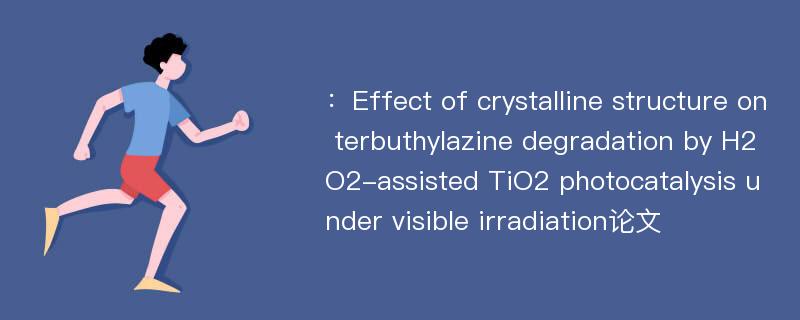
本文主要研究内容
作者(2019)在《Effect of crystalline structure on terbuthylazine degradation by H2O2-assisted TiO2 photocatalysis under visible irradiation》一文中研究指出:Various methods for shifting the optical response of TiO2 into the visible(Vis) range have been reported. Herein, we reported the application of a TiO2/H2O2/Vis process and the effects of TiO2 crystalline structure on the degradation of terbuthylazine. The results indicated that TiO2 crystalline structure and H2O2 addition had significant effects on terbuthylazine degradation: its degradation rate could be increased from 7% to 70% with H2O2 addition after 180 min of reaction, the synergistic degradation of terbuthylazine by TiO2-Fe3+ was substantially accelerated, with the degradation rate reaching up to 100% after20 min of reaction, and rutile TiO2 showed better photocatalytic activity and a more obvious synergistic effect than anatase TiO2. The addition of free-radical scavengers(tert-butyl alcohol or methanol) inhibited the degradation efficiency of rutile TiO2, but had a relatively minor effect on anatase TiO2. Fluorescence spectrophotometry analysis indicated that hydroxyl free radicals could be continuously produced when using rutile TiO2 as the photocatalyst. Degradation of terbuthylazine catalyzed by rutile TiO2 occurred mainly in solution, but occurred on the particle surface of the photocatalyst when catalyzed by anatase TiO2. This study provides new insight into the role of TiO2 crystalline structure on the degradation of terbuthylazine and its photocatalytic degradation mechanism.
Abstract
Various methods for shifting the optical response of TiO2 into the visible(Vis) range have been reported. Herein, we reported the application of a TiO2/H2O2/Vis process and the effects of TiO2 crystalline structure on the degradation of terbuthylazine. The results indicated that TiO2 crystalline structure and H2O2 addition had significant effects on terbuthylazine degradation: its degradation rate could be increased from 7% to 70% with H2O2 addition after 180 min of reaction, the synergistic degradation of terbuthylazine by TiO2-Fe3+ was substantially accelerated, with the degradation rate reaching up to 100% after20 min of reaction, and rutile TiO2 showed better photocatalytic activity and a more obvious synergistic effect than anatase TiO2. The addition of free-radical scavengers(tert-butyl alcohol or methanol) inhibited the degradation efficiency of rutile TiO2, but had a relatively minor effect on anatase TiO2. Fluorescence spectrophotometry analysis indicated that hydroxyl free radicals could be continuously produced when using rutile TiO2 as the photocatalyst. Degradation of terbuthylazine catalyzed by rutile TiO2 occurred mainly in solution, but occurred on the particle surface of the photocatalyst when catalyzed by anatase TiO2. This study provides new insight into the role of TiO2 crystalline structure on the degradation of terbuthylazine and its photocatalytic degradation mechanism.
论文参考文献
论文详细介绍
论文作者分别是来自Journal of Environmental Sciences的,发表于刊物Journal of Environmental Sciences2019年05期论文,是一篇关于,Journal of Environmental Sciences2019年05期论文的文章。本文可供学术参考使用,各位学者可以免费参考阅读下载,文章观点不代表本站观点,资料来自Journal of Environmental Sciences2019年05期论文网站,若本站收录的文献无意侵犯了您的著作版权,请联系我们删除。
